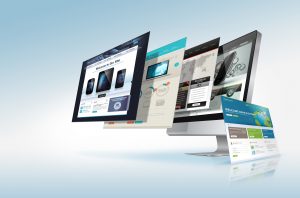Web design has come a long way from when CSS was non-existent. Every now and then a fad will come along that will completely take over the internet. Some of what is considered fashionable in the web design might be all the rage one year, yet completely fall out of favor the following year.
2018 is no different and here at NoRiskSEO.com have a few predictions of what will be trending as well as some design conventions that might die off.
Flat Web Design
Flat design has been around for quite some time. One of the reasons why it’s stuck around for as long as it has, is because it simplifies mobile design. In fact some of the most appealing designs and interfaces for mobile apps feature the flat design.
There’s something about big bold buttons that simply makes the flat design impressive.
The flat design has made its way to websites as well. However according to a survey conducted by the Nielsen Norman Group 22% of users of a site that had a flat design took longer to navigate. Also when using the flat design, weak typography is more difficult to conceal.
There’s speculation that the flat design might not survive beyond 2018.
Video Will Be Even Bigger In 2018
The integration of video as a feature online is nothing new. There’s no debate though that over the past couple of years video has exploded. In fact, a study by Locowise shows that audiences on Facebook are likely to engage with video content more compared to other types of content.
This exponential growth means that it’s now easier than ever to create video content for both your website as well as social media channels. This is because there are numerous tools out there that will enable you to create all kinds of video. For instance, PowToon is a tool that allows you to create animated video content without any animation skills.
You can expect video to continue being a big deal in 2018.
Worth noting though is that not everyone is a huge fan of video. This is especially the case for user interface designers who deal mainly with ecommerce sites. Video is seen more as a distraction that many consider as much of a nuisance as carousels.
Scrolling Effects
Parallax scrolling is no longer in vogue based on the fact that it caused websites to load slow plus it had a negative impact on usability.
This though shouldn’t mean that we shouldn’t try out new scrolling ideas. For instance, having a static background image that remains static while scrolling adds to the user interface’s appeal. You can easily see this when you look at the https://www.madebymany.com site.
This is a trend we’re likely to see in digital advertising in 2018.
<iframe width=”560″ height=”315″ src=”https://www.youtube.com/embed/A-jTMJMh4sU” frameborder=”0″ allow=”autoplay; encrypted-media” allowfullscreen></iframe>
Death of The Ghost Button
When the ghost button first came out many web designers sang high praise for its clean yet unobtrusive design. Ironically, it is this same feature that has made it fall in favor with designers.
The idea of call-to-action buttons is that they should draw the attention of a website’s users. However, due to their “ghost” effect they don’t offer much contrast which means users sometimes can’t see these buttons. Sometimes, the ghost button might be in a color too similar to the background which makes them almost invisible.
As you would expect, websites that use ghost buttons have up to 20% reduction in clicks according to this site.
The ghost button trend is in its last throes and will likely see its final end in 2018.
Sticky Navigation
Don’t get me wrong sticky navigation has been around for quite a bit. I’m just confirming that it won’t be going anytime soon.
A sticky navigation is a navigation that follows the user as they scroll up or down a page, making it easier to navigate to other parts of their website. As more retailers redesign and optimize their ecommerce sites, it’s something we’re seeing more often.
Here’s an example: http://reseau.coop
Curves
No one likes curves from Google to Twitter. Sometime in 2017, Twitter decided that they were going to change how profile photos appeared. Instead of having square edges, profile photos were going to be rounded.
Not one to get left behind, Google followed up with similar changes; taking out the sharp corners of its search box as well as their sub-cards (boxes that have images). Google replaced the sharp edges with rounded corners.
Seeing that Twitter was one of the reasons why many websites decided to move to ghost buttons, I can conclude that curves will be big in 2018.
Web Animation Will Be on The Rise
2018 will be a great year for web animation. There’s an entire world of tools out there that can help you create engaging animations for your website. This is likely to have a significant impact on the number of sites that integrate animations on their sites.
Sometime back Airbnb released Lootie, which is a library that allows mobile apps to integrate animations into the user interface as easily as they do with static images. Many cross-platform sites are likely to try and replicate some of the animations on their own websites for uniformity.
Here’s a list of tools that can help you improve your website’s animation.
- GSAP
GSAP runs solely on JavaScript and will cost you nothing. GSAP is flexible as it works with jQuery objects, SVGs, and Canvas elements. If you’re looking for a robust library for your animation GSAP is definitely worth checking out.
- Anime.js
The Anime.js library does more than just simple animations. Using Anime.js you’re able to design animations that have images, buttons, logos etc. In addition, when you use Anime.js you gain access to an entire gallery of custom-built animations.
- Wicked CSS
Wicked CSS is a bit newer than the aforementioned libraries and has a focus on CSS. Wicked CSS works with CSS3 elements to offer incredible results.
Wicked CSS is ideal for creating both simple and complex animations.
- Animate CSS
You probably have already heard about this one. Animate.css is considered by many to be the definitive resource for web animation. Created by Daniel Deden, Animate.css was created as an easy way to add custom CSS3 animations.
- Tuesday
You can easily use Tuesday to control how elements disappear and reappear. The animations by Tuesday are not glamorous which help them to easily fit in with the rest of the page without detracting from the user experience.
- CSShake
CSShake is probably the most unusual of all the libraries mentioned. Basically, it makes it possible for hover animations to have shake effects in all kinds of styles while running on nothing but CSS. You can set your hover animations to have a mild shake or to have a vigorous shake.
- Mo.js
The name gives away what kind of animation Mo.js is involved in. If you’re still wondering, think motion graphics. Mo.js isn’t really designed for user interface animations. However, if you can master it, you can use it for almost anything.
You can use Mo.js to animate several features of your website including logo, navbar or other complex objects.
Hope you’re in a better position of knowing what features you should seriously consider integrating into your website in 2018.




